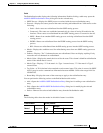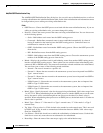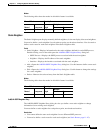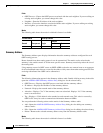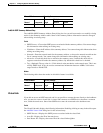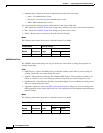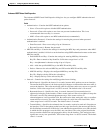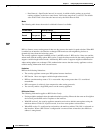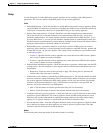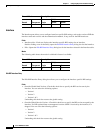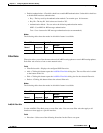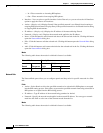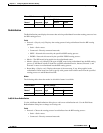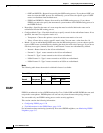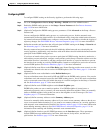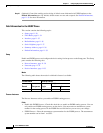
11-23
Cisco ASDM User Guide
OL-16647-01
Chapter 11 Configuring Dynamic And Static Routing
Dynamic Routing
Setup
Use the Setup pane to enable RIP on the security appliance and to configure global RIP protocol
parameters. You can only enable a single RIP process on the security appliance.
Fields
• Enable RIP Routing—Check this check box to enable RIP routing on the security appliance. When
you enable RIP, it is enabled on all interfaces. Checking this check box also enables the other fields
on this pane. Uncheck this check box to disable RIP routing on the security appliance.
• Enable Auto-summarization—Clear this check box to disable automatic route summarization.
Check this check box to reenable automatic route summarization. RIP Version 1 always uses
automatic summarization. You cannot disable automatic summarization for RIP Version 1. If you
are using RIP Version 2, you can turn off automatic summarization by unchecking this check box.
Disable automatic summarization if you must perform routing between disconnected subnets. When
automatic summarization is disabled, subnets are advertised.
• Enable RIP version—Check this check box to specify the version of RIP used by the security
appliance. If this check box is cleared, then the security appliance sends RIP Version 1 updates and
accepts RIP Version 1 & Version 2 updates. This setting can be overridden on a per-interface basis
in the Interface pane.
–
Version 1—Specifies that the security appliance only sends and receives RIP Version 1 updates.
Any version 2 updates received are dropped.
–
Version 2—Specifies that the security appliance only sends and receives RIP Version 2 updates.
Any version 1 updates received are dropped.
• Enable default information originate—Check this check box to generate a default route into the RIP
routing process. You can configure a route map that must be satisfied before the default route can
be generated.
–
Route-map—Enter the name of the route map to apply. The routing process generates the
default route if the route map is satisfied.
• IP Network to Add—Defines a network for the RIP routing process. The network number specified
must not contain any subnet information. There is no limit to the number of network you can add to
the security appliance configuration. RIP routing updates will be sent and received only through
interfaces on the specified networks. Also, if the network of an interface is not specified, the
interface will not be advertised in any RIP updates.
–
Add—Click this button to add the specified network to the list of networks.
–
Delete—Click this button to removed the selected network from the list of networks.
• Configure interfaces as passive globally—Check this check box to set all interfaces on the security
appliance to passive RIP mode. The security appliance listens for RIP routing broadcasts on all
interfaces and uses that information to populate the routing tables but do not broadcast routing
updates. To set specific interfaces to passive RIP, use the Passive Interfaces table.
• Passive Interfaces table—Lists the configured interfaces on the security appliance. Check the check
box in the Passive column for those interfaces you want to operate in passive mode. The other
interfaces will still send and receive RIP broadcasts.
Modes
The following table shows the modes in which this feature is available:



